Sainsbury: Leadership, Management, and Operational Approaches Report
VerifiedAdded on 2021/02/20
|10
|3336
|16
Report
AI Summary
This report examines the management and operations of Sainsbury's, a major UK supermarket chain. It begins by defining the roles and characteristics of leaders and managers, highlighting their differences. The report then explores how leaders and managers function in various situations, including stable, slow-to-moderate changing, and rapidly changing environments. It delves into leadership theories like contingency, situational, and system leadership, and discusses operational management approaches such as Total Quality Management, Just-in-Time, Six Sigma, and Kaizen. The report emphasizes the importance of effective management and operations in achieving business objectives, considering perspectives and their impact on the company's overall success. The analysis provides insights into how Sainsbury's can optimize its leadership and operational strategies for improved performance and consumer satisfaction.
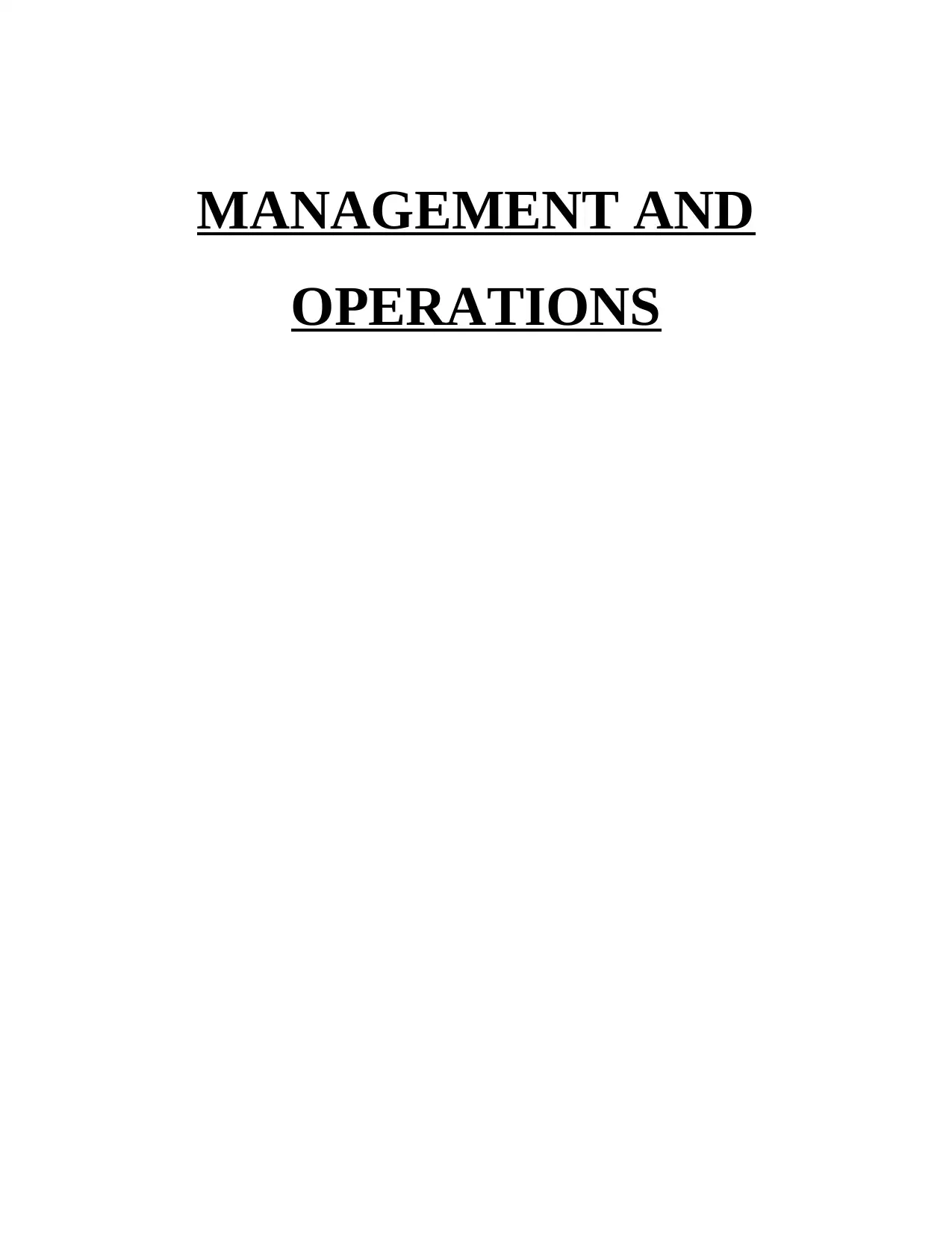
MANAGEMENT AND
OPERATIONS
OPERATIONS
Paraphrase This Document
Need a fresh take? Get an instant paraphrase of this document with our AI Paraphraser
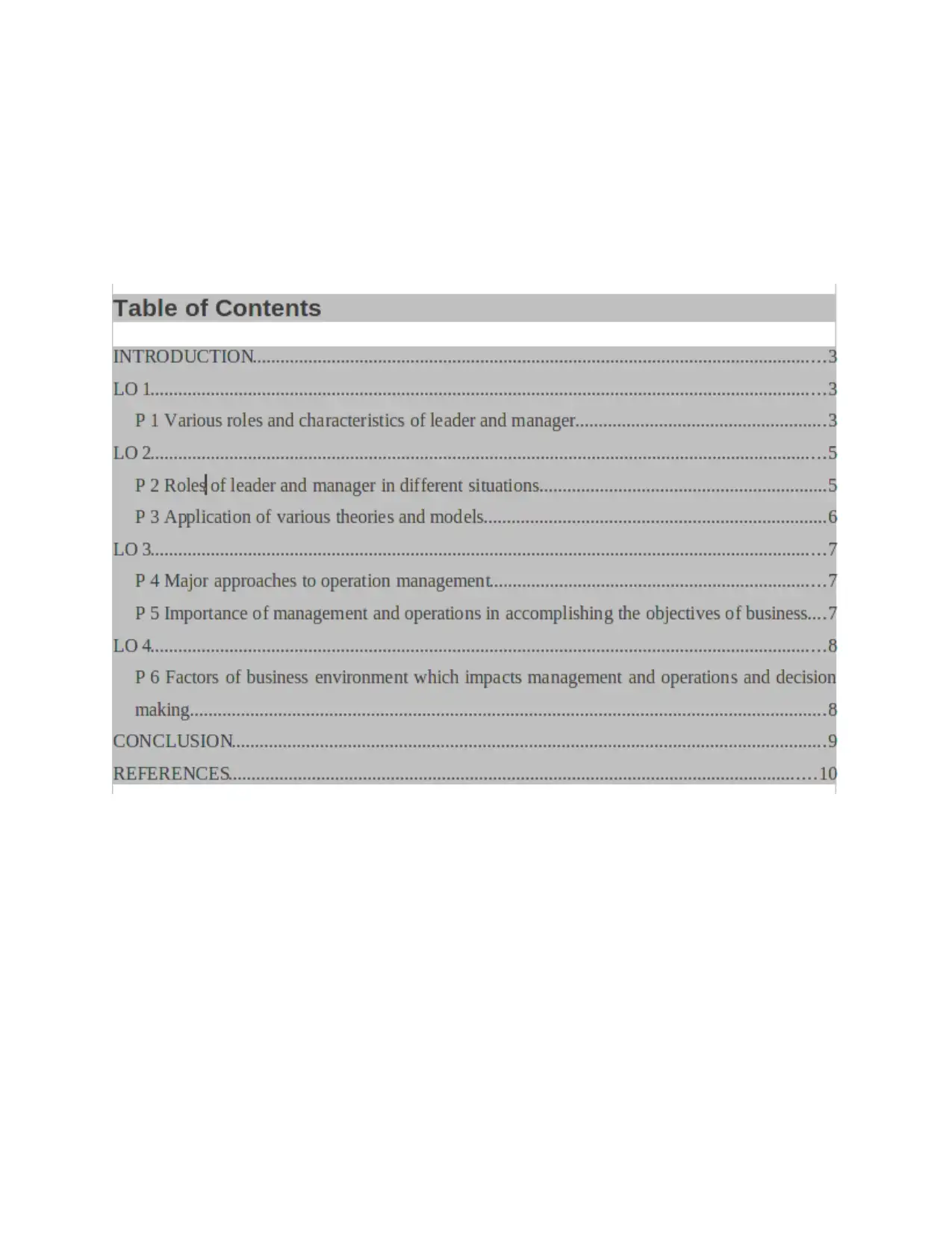
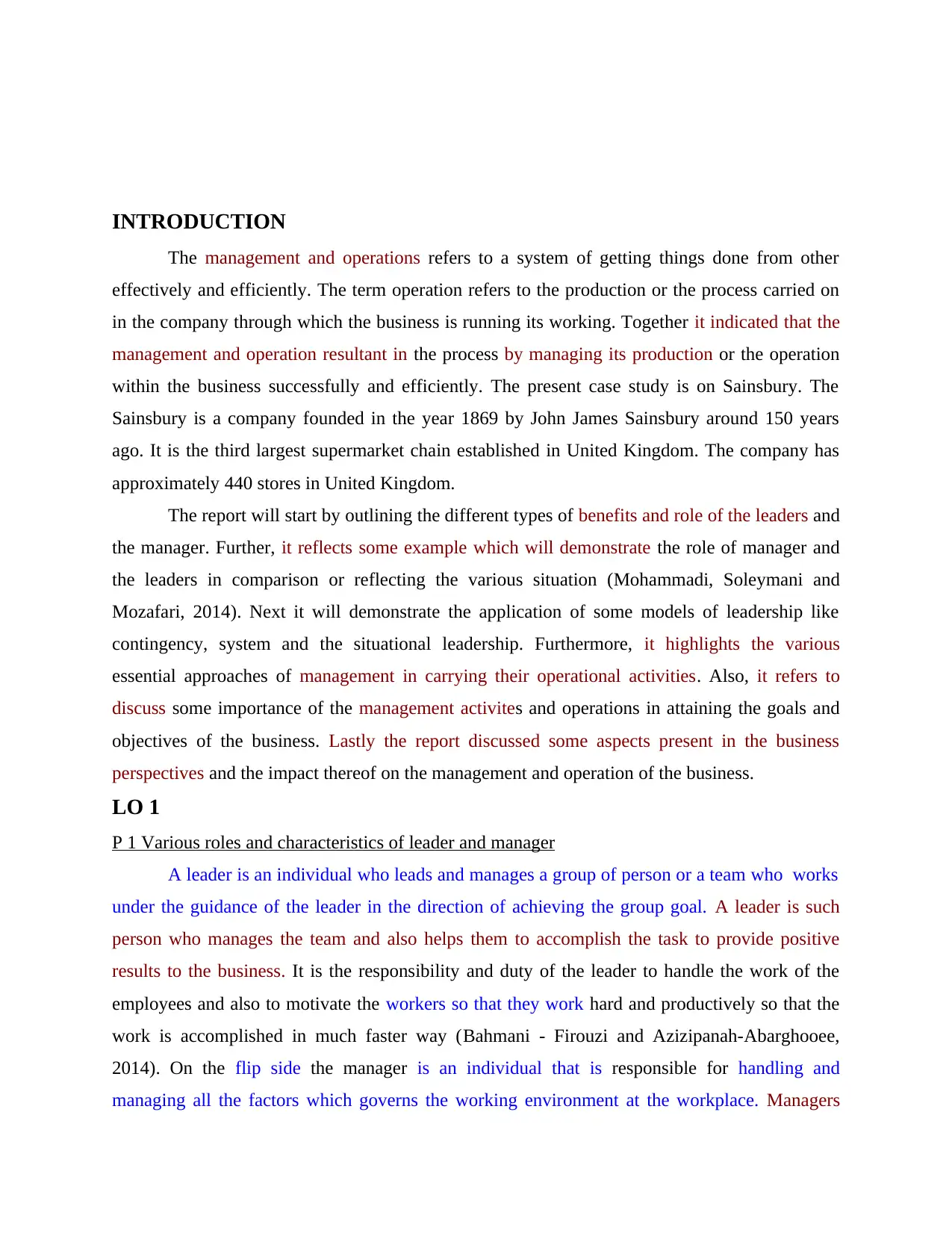
INTRODUCTION
The management and operations refers to a system of getting things done from other
effectively and efficiently. The term operation refers to the production or the process carried on
in the company through which the business is running its working. Together it indicated that the
management and operation resultant in the process by managing its production or the operation
within the business successfully and efficiently. The present case study is on Sainsbury. The
Sainsbury is a company founded in the year 1869 by John James Sainsbury around 150 years
ago. It is the third largest supermarket chain established in United Kingdom. The company has
approximately 440 stores in United Kingdom.
The report will start by outlining the different types of benefits and role of the leaders and
the manager. Further, it reflects some example which will demonstrate the role of manager and
the leaders in comparison or reflecting the various situation (Mohammadi, Soleymani and
Mozafari, 2014). Next it will demonstrate the application of some models of leadership like
contingency, system and the situational leadership. Furthermore, it highlights the various
essential approaches of management in carrying their operational activities. Also, it refers to
discuss some importance of the management activites and operations in attaining the goals and
objectives of the business. Lastly the report discussed some aspects present in the business
perspectives and the impact thereof on the management and operation of the business.
LO 1
P 1 Various roles and characteristics of leader and manager
A leader is an individual who leads and manages a group of person or a team who works
under the guidance of the leader in the direction of achieving the group goal. A leader is such
person who manages the team and also helps them to accomplish the task to provide positive
results to the business. It is the responsibility and duty of the leader to handle the work of the
employees and also to motivate the workers so that they work hard and productively so that the
work is accomplished in much faster way (Bahmani - Firouzi and Azizipanah-Abarghooee,
2014). On the flip side the manager is an individual that is responsible for handling and
managing all the factors which governs the working environment at the workplace. Managers
The management and operations refers to a system of getting things done from other
effectively and efficiently. The term operation refers to the production or the process carried on
in the company through which the business is running its working. Together it indicated that the
management and operation resultant in the process by managing its production or the operation
within the business successfully and efficiently. The present case study is on Sainsbury. The
Sainsbury is a company founded in the year 1869 by John James Sainsbury around 150 years
ago. It is the third largest supermarket chain established in United Kingdom. The company has
approximately 440 stores in United Kingdom.
The report will start by outlining the different types of benefits and role of the leaders and
the manager. Further, it reflects some example which will demonstrate the role of manager and
the leaders in comparison or reflecting the various situation (Mohammadi, Soleymani and
Mozafari, 2014). Next it will demonstrate the application of some models of leadership like
contingency, system and the situational leadership. Furthermore, it highlights the various
essential approaches of management in carrying their operational activities. Also, it refers to
discuss some importance of the management activites and operations in attaining the goals and
objectives of the business. Lastly the report discussed some aspects present in the business
perspectives and the impact thereof on the management and operation of the business.
LO 1
P 1 Various roles and characteristics of leader and manager
A leader is an individual who leads and manages a group of person or a team who works
under the guidance of the leader in the direction of achieving the group goal. A leader is such
person who manages the team and also helps them to accomplish the task to provide positive
results to the business. It is the responsibility and duty of the leader to handle the work of the
employees and also to motivate the workers so that they work hard and productively so that the
work is accomplished in much faster way (Bahmani - Firouzi and Azizipanah-Abarghooee,
2014). On the flip side the manager is an individual that is responsible for handling and
managing all the factors which governs the working environment at the workplace. Managers
⊘ This is a preview!⊘
Do you want full access?
Subscribe today to unlock all pages.

Trusted by 1+ million students worldwide
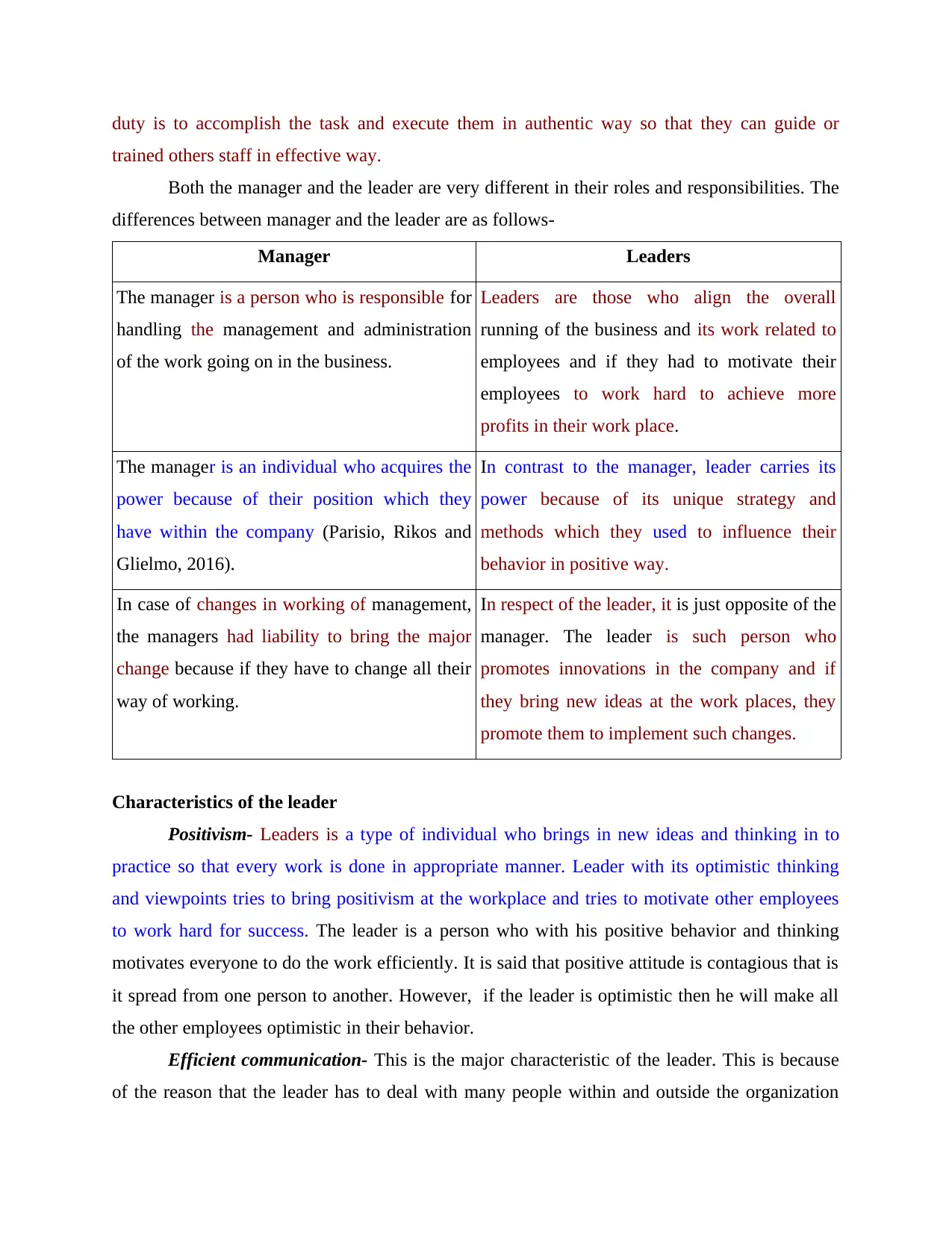
duty is to accomplish the task and execute them in authentic way so that they can guide or
trained others staff in effective way.
Both the manager and the leader are very different in their roles and responsibilities. The
differences between manager and the leader are as follows-
Manager Leaders
The manager is a person who is responsible for
handling the management and administration
of the work going on in the business.
Leaders are those who align the overall
running of the business and its work related to
employees and if they had to motivate their
employees to work hard to achieve more
profits in their work place.
The manager is an individual who acquires the
power because of their position which they
have within the company (Parisio, Rikos and
Glielmo, 2016).
In contrast to the manager, leader carries its
power because of its unique strategy and
methods which they used to influence their
behavior in positive way.
In case of changes in working of management,
the managers had liability to bring the major
change because if they have to change all their
way of working.
In respect of the leader, it is just opposite of the
manager. The leader is such person who
promotes innovations in the company and if
they bring new ideas at the work places, they
promote them to implement such changes.
Characteristics of the leader
Positivism- Leaders is a type of individual who brings in new ideas and thinking in to
practice so that every work is done in appropriate manner. Leader with its optimistic thinking
and viewpoints tries to bring positivism at the workplace and tries to motivate other employees
to work hard for success. The leader is a person who with his positive behavior and thinking
motivates everyone to do the work efficiently. It is said that positive attitude is contagious that is
it spread from one person to another. However, if the leader is optimistic then he will make all
the other employees optimistic in their behavior.
Efficient communication- This is the major characteristic of the leader. This is because
of the reason that the leader has to deal with many people within and outside the organization
trained others staff in effective way.
Both the manager and the leader are very different in their roles and responsibilities. The
differences between manager and the leader are as follows-
Manager Leaders
The manager is a person who is responsible for
handling the management and administration
of the work going on in the business.
Leaders are those who align the overall
running of the business and its work related to
employees and if they had to motivate their
employees to work hard to achieve more
profits in their work place.
The manager is an individual who acquires the
power because of their position which they
have within the company (Parisio, Rikos and
Glielmo, 2016).
In contrast to the manager, leader carries its
power because of its unique strategy and
methods which they used to influence their
behavior in positive way.
In case of changes in working of management,
the managers had liability to bring the major
change because if they have to change all their
way of working.
In respect of the leader, it is just opposite of the
manager. The leader is such person who
promotes innovations in the company and if
they bring new ideas at the work places, they
promote them to implement such changes.
Characteristics of the leader
Positivism- Leaders is a type of individual who brings in new ideas and thinking in to
practice so that every work is done in appropriate manner. Leader with its optimistic thinking
and viewpoints tries to bring positivism at the workplace and tries to motivate other employees
to work hard for success. The leader is a person who with his positive behavior and thinking
motivates everyone to do the work efficiently. It is said that positive attitude is contagious that is
it spread from one person to another. However, if the leader is optimistic then he will make all
the other employees optimistic in their behavior.
Efficient communication- This is the major characteristic of the leader. This is because
of the reason that the leader has to deal with many people within and outside the organization
Paraphrase This Document
Need a fresh take? Get an instant paraphrase of this document with our AI Paraphraser
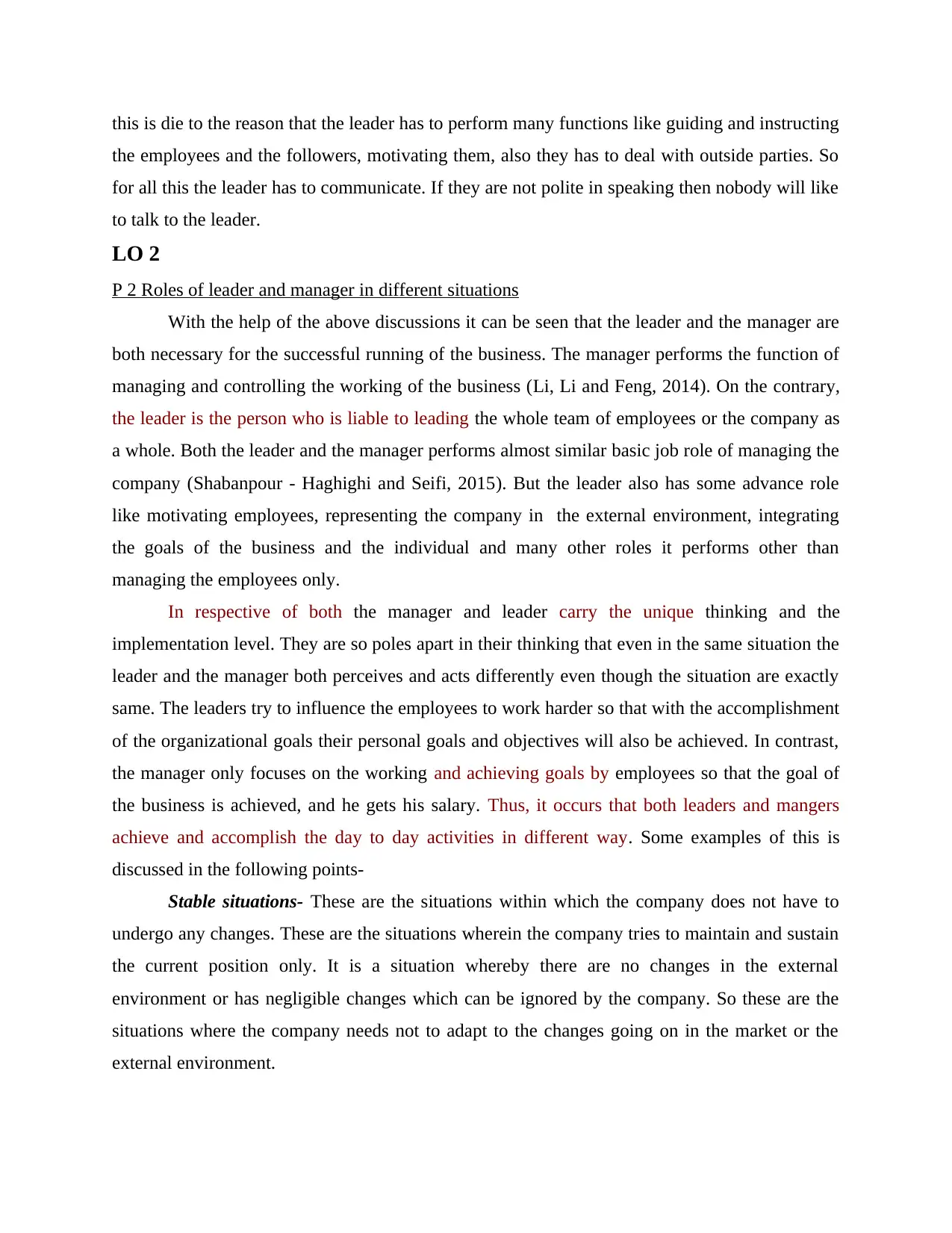
this is die to the reason that the leader has to perform many functions like guiding and instructing
the employees and the followers, motivating them, also they has to deal with outside parties. So
for all this the leader has to communicate. If they are not polite in speaking then nobody will like
to talk to the leader.
LO 2
P 2 Roles of leader and manager in different situations
With the help of the above discussions it can be seen that the leader and the manager are
both necessary for the successful running of the business. The manager performs the function of
managing and controlling the working of the business (Li, Li and Feng, 2014). On the contrary,
the leader is the person who is liable to leading the whole team of employees or the company as
a whole. Both the leader and the manager performs almost similar basic job role of managing the
company (Shabanpour - Haghighi and Seifi, 2015). But the leader also has some advance role
like motivating employees, representing the company in the external environment, integrating
the goals of the business and the individual and many other roles it performs other than
managing the employees only.
In respective of both the manager and leader carry the unique thinking and the
implementation level. They are so poles apart in their thinking that even in the same situation the
leader and the manager both perceives and acts differently even though the situation are exactly
same. The leaders try to influence the employees to work harder so that with the accomplishment
of the organizational goals their personal goals and objectives will also be achieved. In contrast,
the manager only focuses on the working and achieving goals by employees so that the goal of
the business is achieved, and he gets his salary. Thus, it occurs that both leaders and mangers
achieve and accomplish the day to day activities in different way. Some examples of this is
discussed in the following points-
Stable situations- These are the situations within which the company does not have to
undergo any changes. These are the situations wherein the company tries to maintain and sustain
the current position only. It is a situation whereby there are no changes in the external
environment or has negligible changes which can be ignored by the company. So these are the
situations where the company needs not to adapt to the changes going on in the market or the
external environment.
the employees and the followers, motivating them, also they has to deal with outside parties. So
for all this the leader has to communicate. If they are not polite in speaking then nobody will like
to talk to the leader.
LO 2
P 2 Roles of leader and manager in different situations
With the help of the above discussions it can be seen that the leader and the manager are
both necessary for the successful running of the business. The manager performs the function of
managing and controlling the working of the business (Li, Li and Feng, 2014). On the contrary,
the leader is the person who is liable to leading the whole team of employees or the company as
a whole. Both the leader and the manager performs almost similar basic job role of managing the
company (Shabanpour - Haghighi and Seifi, 2015). But the leader also has some advance role
like motivating employees, representing the company in the external environment, integrating
the goals of the business and the individual and many other roles it performs other than
managing the employees only.
In respective of both the manager and leader carry the unique thinking and the
implementation level. They are so poles apart in their thinking that even in the same situation the
leader and the manager both perceives and acts differently even though the situation are exactly
same. The leaders try to influence the employees to work harder so that with the accomplishment
of the organizational goals their personal goals and objectives will also be achieved. In contrast,
the manager only focuses on the working and achieving goals by employees so that the goal of
the business is achieved, and he gets his salary. Thus, it occurs that both leaders and mangers
achieve and accomplish the day to day activities in different way. Some examples of this is
discussed in the following points-
Stable situations- These are the situations within which the company does not have to
undergo any changes. These are the situations wherein the company tries to maintain and sustain
the current position only. It is a situation whereby there are no changes in the external
environment or has negligible changes which can be ignored by the company. So these are the
situations where the company needs not to adapt to the changes going on in the market or the
external environment.
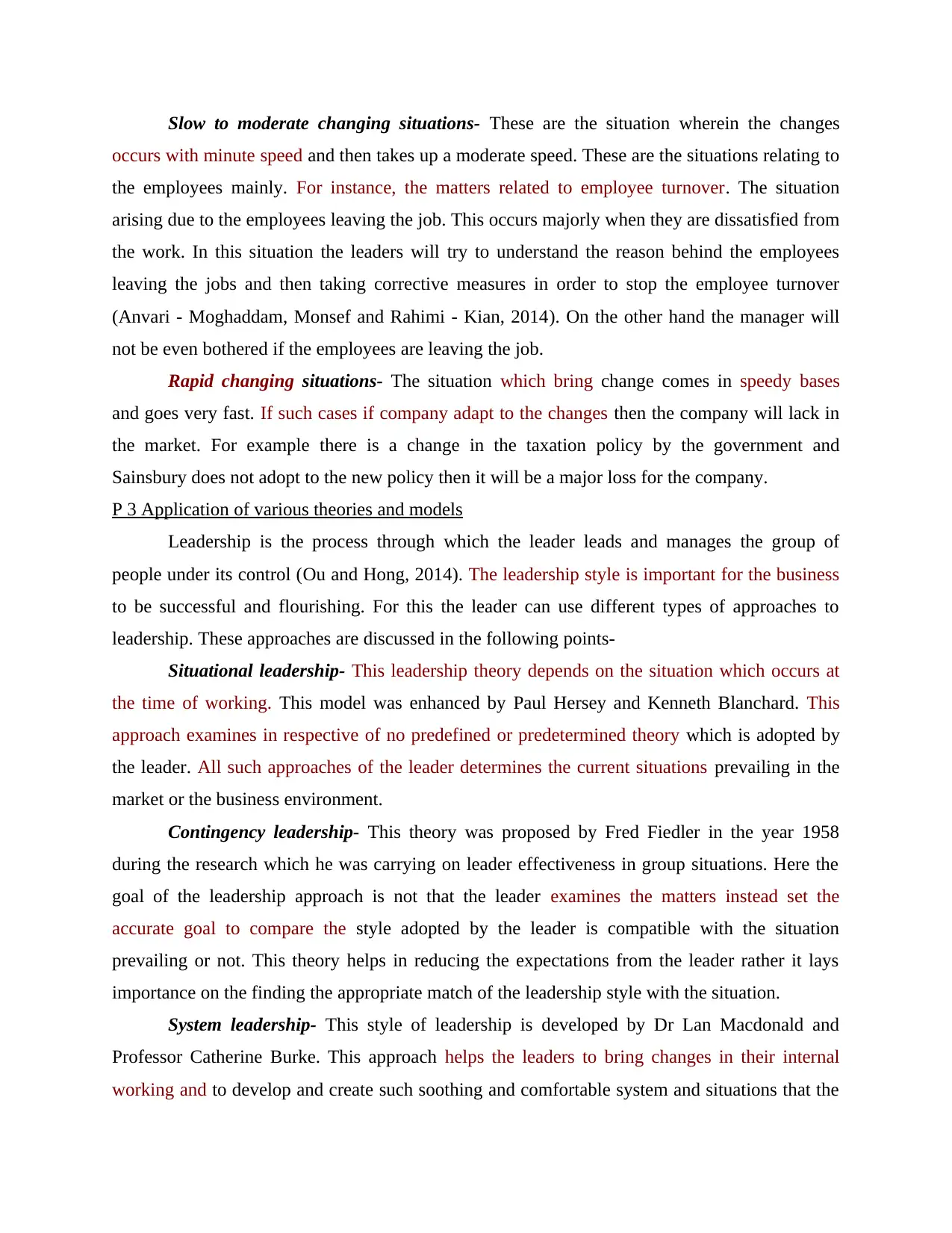
Slow to moderate changing situations- These are the situation wherein the changes
occurs with minute speed and then takes up a moderate speed. These are the situations relating to
the employees mainly. For instance, the matters related to employee turnover. The situation
arising due to the employees leaving the job. This occurs majorly when they are dissatisfied from
the work. In this situation the leaders will try to understand the reason behind the employees
leaving the jobs and then taking corrective measures in order to stop the employee turnover
(Anvari - Moghaddam, Monsef and Rahimi - Kian, 2014). On the other hand the manager will
not be even bothered if the employees are leaving the job.
Rapid changing situations- The situation which bring change comes in speedy bases
and goes very fast. If such cases if company adapt to the changes then the company will lack in
the market. For example there is a change in the taxation policy by the government and
Sainsbury does not adopt to the new policy then it will be a major loss for the company.
P 3 Application of various theories and models
Leadership is the process through which the leader leads and manages the group of
people under its control (Ou and Hong, 2014). The leadership style is important for the business
to be successful and flourishing. For this the leader can use different types of approaches to
leadership. These approaches are discussed in the following points-
Situational leadership- This leadership theory depends on the situation which occurs at
the time of working. This model was enhanced by Paul Hersey and Kenneth Blanchard. This
approach examines in respective of no predefined or predetermined theory which is adopted by
the leader. All such approaches of the leader determines the current situations prevailing in the
market or the business environment.
Contingency leadership- This theory was proposed by Fred Fiedler in the year 1958
during the research which he was carrying on leader effectiveness in group situations. Here the
goal of the leadership approach is not that the leader examines the matters instead set the
accurate goal to compare the style adopted by the leader is compatible with the situation
prevailing or not. This theory helps in reducing the expectations from the leader rather it lays
importance on the finding the appropriate match of the leadership style with the situation.
System leadership- This style of leadership is developed by Dr Lan Macdonald and
Professor Catherine Burke. This approach helps the leaders to bring changes in their internal
working and to develop and create such soothing and comfortable system and situations that the
occurs with minute speed and then takes up a moderate speed. These are the situations relating to
the employees mainly. For instance, the matters related to employee turnover. The situation
arising due to the employees leaving the job. This occurs majorly when they are dissatisfied from
the work. In this situation the leaders will try to understand the reason behind the employees
leaving the jobs and then taking corrective measures in order to stop the employee turnover
(Anvari - Moghaddam, Monsef and Rahimi - Kian, 2014). On the other hand the manager will
not be even bothered if the employees are leaving the job.
Rapid changing situations- The situation which bring change comes in speedy bases
and goes very fast. If such cases if company adapt to the changes then the company will lack in
the market. For example there is a change in the taxation policy by the government and
Sainsbury does not adopt to the new policy then it will be a major loss for the company.
P 3 Application of various theories and models
Leadership is the process through which the leader leads and manages the group of
people under its control (Ou and Hong, 2014). The leadership style is important for the business
to be successful and flourishing. For this the leader can use different types of approaches to
leadership. These approaches are discussed in the following points-
Situational leadership- This leadership theory depends on the situation which occurs at
the time of working. This model was enhanced by Paul Hersey and Kenneth Blanchard. This
approach examines in respective of no predefined or predetermined theory which is adopted by
the leader. All such approaches of the leader determines the current situations prevailing in the
market or the business environment.
Contingency leadership- This theory was proposed by Fred Fiedler in the year 1958
during the research which he was carrying on leader effectiveness in group situations. Here the
goal of the leadership approach is not that the leader examines the matters instead set the
accurate goal to compare the style adopted by the leader is compatible with the situation
prevailing or not. This theory helps in reducing the expectations from the leader rather it lays
importance on the finding the appropriate match of the leadership style with the situation.
System leadership- This style of leadership is developed by Dr Lan Macdonald and
Professor Catherine Burke. This approach helps the leaders to bring changes in their internal
working and to develop and create such soothing and comfortable system and situations that the
⊘ This is a preview!⊘
Do you want full access?
Subscribe today to unlock all pages.

Trusted by 1+ million students worldwide
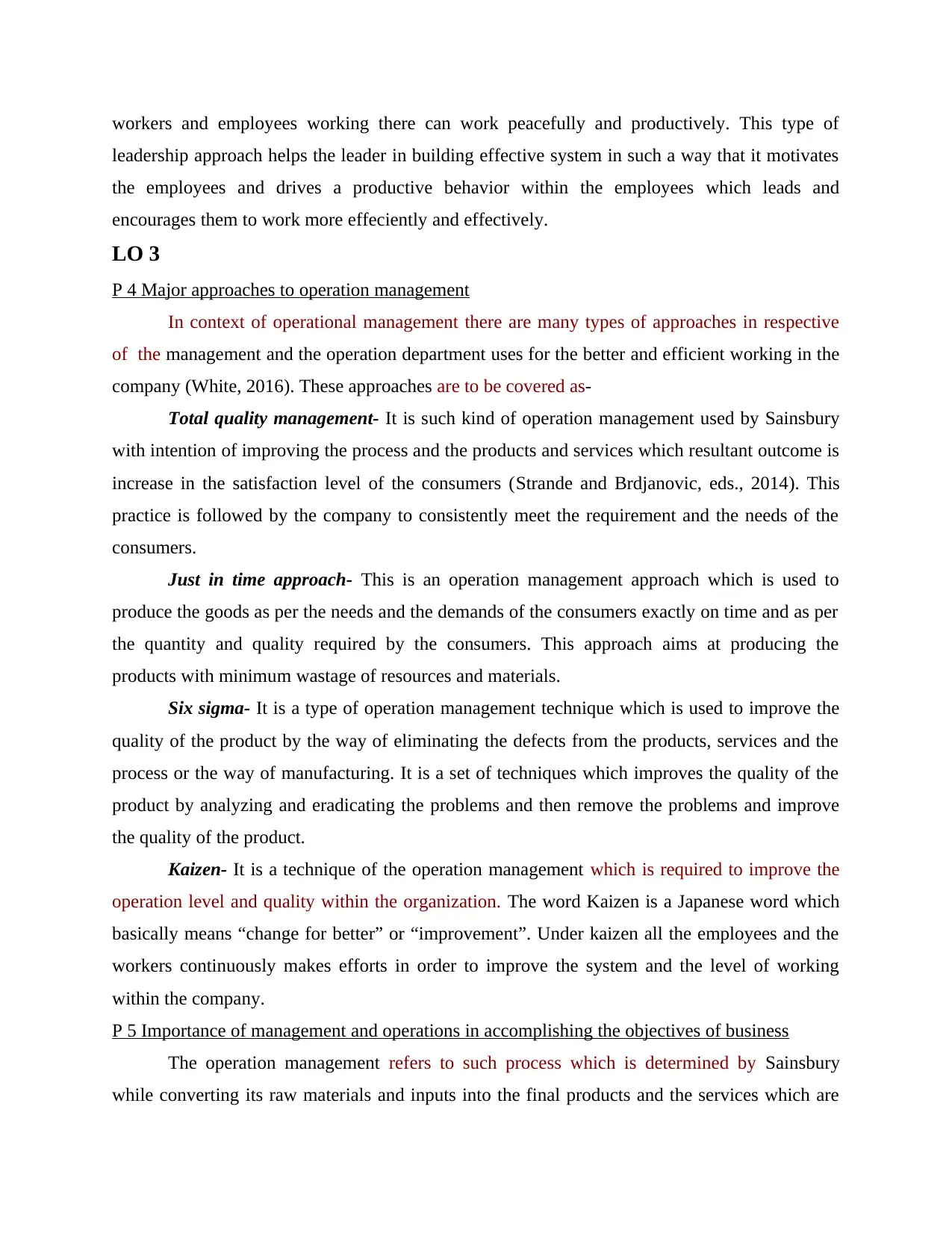
workers and employees working there can work peacefully and productively. This type of
leadership approach helps the leader in building effective system in such a way that it motivates
the employees and drives a productive behavior within the employees which leads and
encourages them to work more effeciently and effectively.
LO 3
P 4 Major approaches to operation management
In context of operational management there are many types of approaches in respective
of the management and the operation department uses for the better and efficient working in the
company (White, 2016). These approaches are to be covered as-
Total quality management- It is such kind of operation management used by Sainsbury
with intention of improving the process and the products and services which resultant outcome is
increase in the satisfaction level of the consumers (Strande and Brdjanovic, eds., 2014). This
practice is followed by the company to consistently meet the requirement and the needs of the
consumers.
Just in time approach- This is an operation management approach which is used to
produce the goods as per the needs and the demands of the consumers exactly on time and as per
the quantity and quality required by the consumers. This approach aims at producing the
products with minimum wastage of resources and materials.
Six sigma- It is a type of operation management technique which is used to improve the
quality of the product by the way of eliminating the defects from the products, services and the
process or the way of manufacturing. It is a set of techniques which improves the quality of the
product by analyzing and eradicating the problems and then remove the problems and improve
the quality of the product.
Kaizen- It is a technique of the operation management which is required to improve the
operation level and quality within the organization. The word Kaizen is a Japanese word which
basically means “change for better” or “improvement”. Under kaizen all the employees and the
workers continuously makes efforts in order to improve the system and the level of working
within the company.
P 5 Importance of management and operations in accomplishing the objectives of business
The operation management refers to such process which is determined by Sainsbury
while converting its raw materials and inputs into the final products and the services which are
leadership approach helps the leader in building effective system in such a way that it motivates
the employees and drives a productive behavior within the employees which leads and
encourages them to work more effeciently and effectively.
LO 3
P 4 Major approaches to operation management
In context of operational management there are many types of approaches in respective
of the management and the operation department uses for the better and efficient working in the
company (White, 2016). These approaches are to be covered as-
Total quality management- It is such kind of operation management used by Sainsbury
with intention of improving the process and the products and services which resultant outcome is
increase in the satisfaction level of the consumers (Strande and Brdjanovic, eds., 2014). This
practice is followed by the company to consistently meet the requirement and the needs of the
consumers.
Just in time approach- This is an operation management approach which is used to
produce the goods as per the needs and the demands of the consumers exactly on time and as per
the quantity and quality required by the consumers. This approach aims at producing the
products with minimum wastage of resources and materials.
Six sigma- It is a type of operation management technique which is used to improve the
quality of the product by the way of eliminating the defects from the products, services and the
process or the way of manufacturing. It is a set of techniques which improves the quality of the
product by analyzing and eradicating the problems and then remove the problems and improve
the quality of the product.
Kaizen- It is a technique of the operation management which is required to improve the
operation level and quality within the organization. The word Kaizen is a Japanese word which
basically means “change for better” or “improvement”. Under kaizen all the employees and the
workers continuously makes efforts in order to improve the system and the level of working
within the company.
P 5 Importance of management and operations in accomplishing the objectives of business
The operation management refers to such process which is determined by Sainsbury
while converting its raw materials and inputs into the final products and the services which are
Paraphrase This Document
Need a fresh take? Get an instant paraphrase of this document with our AI Paraphraser
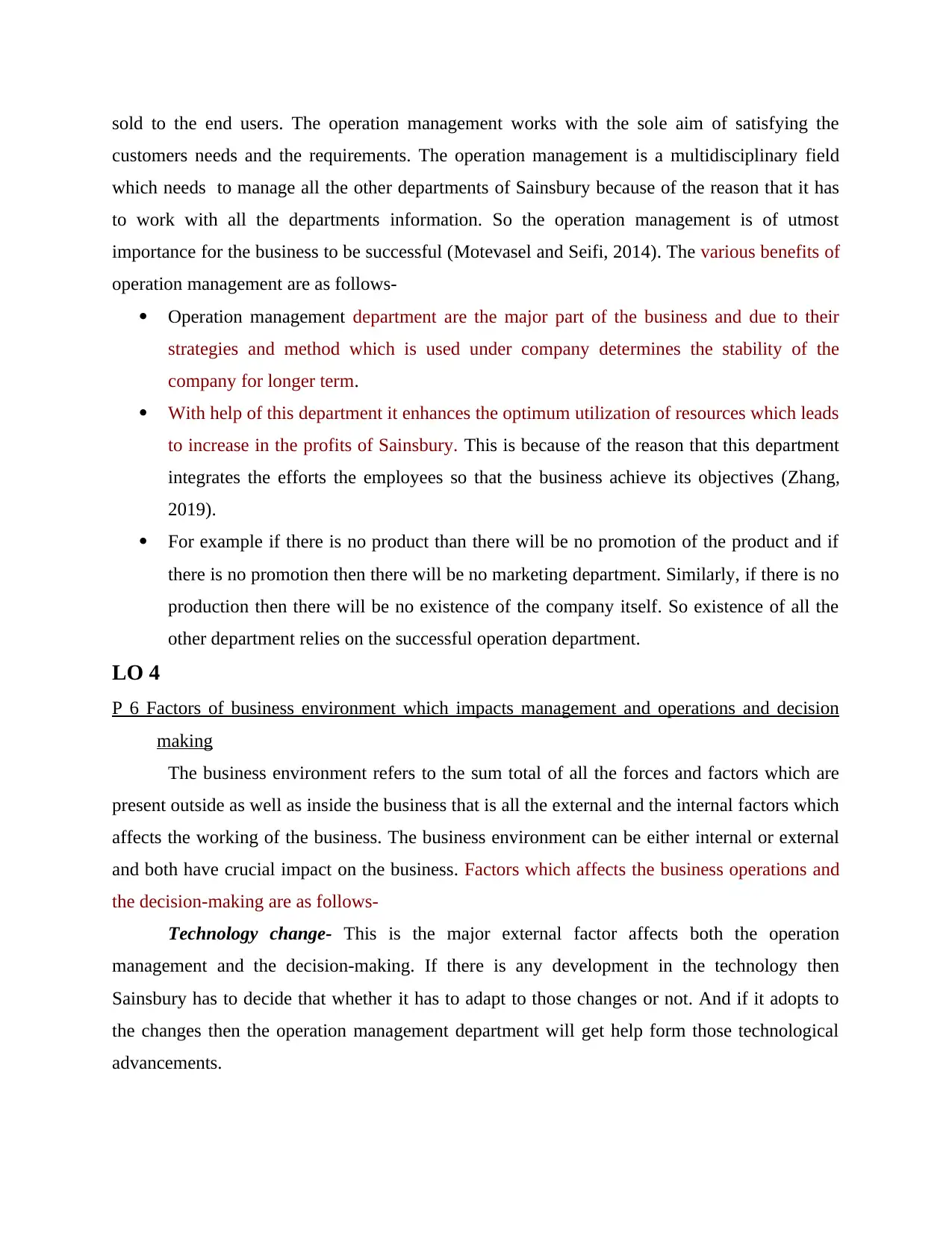
sold to the end users. The operation management works with the sole aim of satisfying the
customers needs and the requirements. The operation management is a multidisciplinary field
which needs to manage all the other departments of Sainsbury because of the reason that it has
to work with all the departments information. So the operation management is of utmost
importance for the business to be successful (Motevasel and Seifi, 2014). The various benefits of
operation management are as follows-
Operation management department are the major part of the business and due to their
strategies and method which is used under company determines the stability of the
company for longer term.
With help of this department it enhances the optimum utilization of resources which leads
to increase in the profits of Sainsbury. This is because of the reason that this department
integrates the efforts the employees so that the business achieve its objectives (Zhang,
2019).
For example if there is no product than there will be no promotion of the product and if
there is no promotion then there will be no marketing department. Similarly, if there is no
production then there will be no existence of the company itself. So existence of all the
other department relies on the successful operation department.
LO 4
P 6 Factors of business environment which impacts management and operations and decision
making
The business environment refers to the sum total of all the forces and factors which are
present outside as well as inside the business that is all the external and the internal factors which
affects the working of the business. The business environment can be either internal or external
and both have crucial impact on the business. Factors which affects the business operations and
the decision-making are as follows-
Technology change- This is the major external factor affects both the operation
management and the decision-making. If there is any development in the technology then
Sainsbury has to decide that whether it has to adapt to those changes or not. And if it adopts to
the changes then the operation management department will get help form those technological
advancements.
customers needs and the requirements. The operation management is a multidisciplinary field
which needs to manage all the other departments of Sainsbury because of the reason that it has
to work with all the departments information. So the operation management is of utmost
importance for the business to be successful (Motevasel and Seifi, 2014). The various benefits of
operation management are as follows-
Operation management department are the major part of the business and due to their
strategies and method which is used under company determines the stability of the
company for longer term.
With help of this department it enhances the optimum utilization of resources which leads
to increase in the profits of Sainsbury. This is because of the reason that this department
integrates the efforts the employees so that the business achieve its objectives (Zhang,
2019).
For example if there is no product than there will be no promotion of the product and if
there is no promotion then there will be no marketing department. Similarly, if there is no
production then there will be no existence of the company itself. So existence of all the
other department relies on the successful operation department.
LO 4
P 6 Factors of business environment which impacts management and operations and decision
making
The business environment refers to the sum total of all the forces and factors which are
present outside as well as inside the business that is all the external and the internal factors which
affects the working of the business. The business environment can be either internal or external
and both have crucial impact on the business. Factors which affects the business operations and
the decision-making are as follows-
Technology change- This is the major external factor affects both the operation
management and the decision-making. If there is any development in the technology then
Sainsbury has to decide that whether it has to adapt to those changes or not. And if it adopts to
the changes then the operation management department will get help form those technological
advancements.
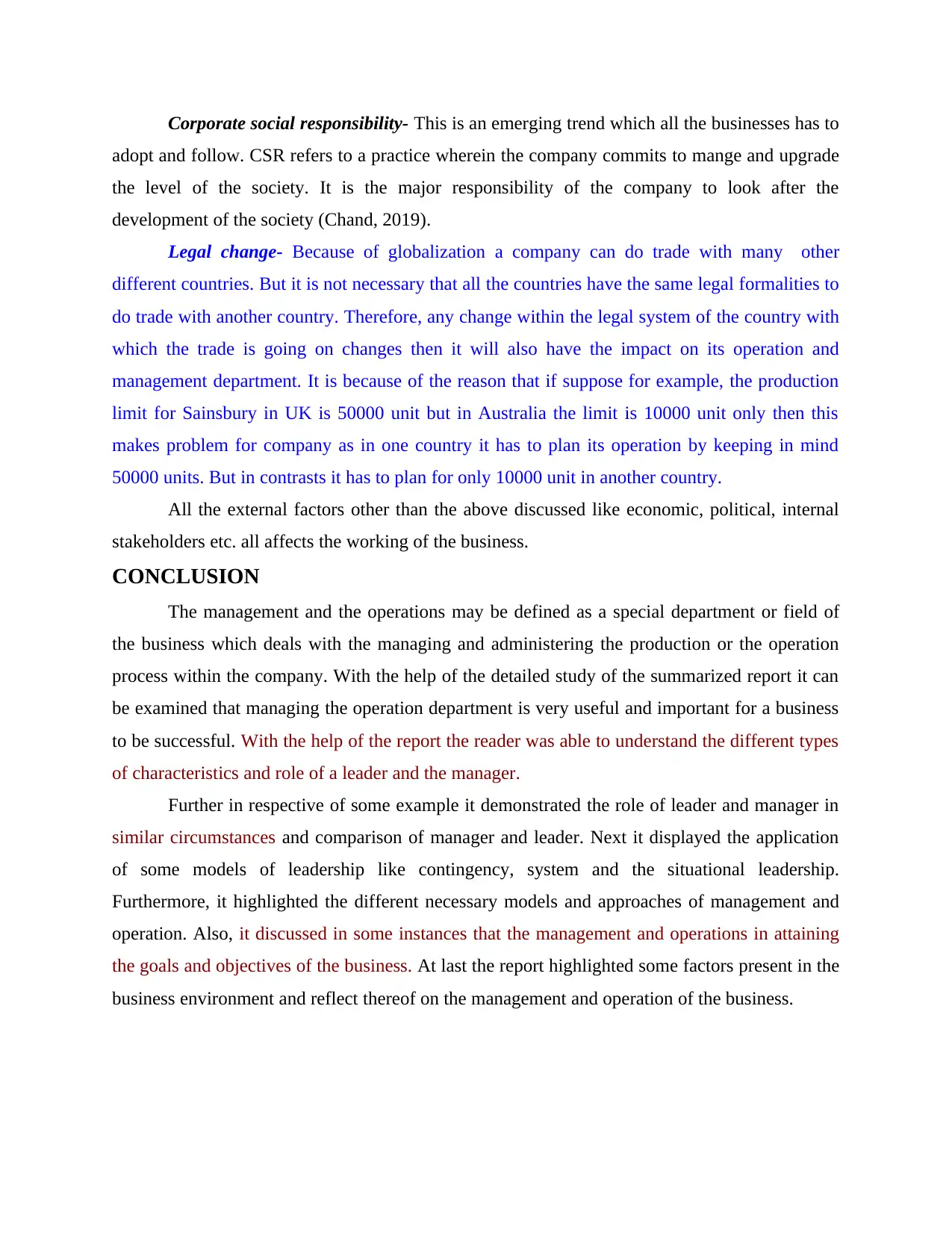
Corporate social responsibility- This is an emerging trend which all the businesses has to
adopt and follow. CSR refers to a practice wherein the company commits to mange and upgrade
the level of the society. It is the major responsibility of the company to look after the
development of the society (Chand, 2019).
Legal change- Because of globalization a company can do trade with many other
different countries. But it is not necessary that all the countries have the same legal formalities to
do trade with another country. Therefore, any change within the legal system of the country with
which the trade is going on changes then it will also have the impact on its operation and
management department. It is because of the reason that if suppose for example, the production
limit for Sainsbury in UK is 50000 unit but in Australia the limit is 10000 unit only then this
makes problem for company as in one country it has to plan its operation by keeping in mind
50000 units. But in contrasts it has to plan for only 10000 unit in another country.
All the external factors other than the above discussed like economic, political, internal
stakeholders etc. all affects the working of the business.
CONCLUSION
The management and the operations may be defined as a special department or field of
the business which deals with the managing and administering the production or the operation
process within the company. With the help of the detailed study of the summarized report it can
be examined that managing the operation department is very useful and important for a business
to be successful. With the help of the report the reader was able to understand the different types
of characteristics and role of a leader and the manager.
Further in respective of some example it demonstrated the role of leader and manager in
similar circumstances and comparison of manager and leader. Next it displayed the application
of some models of leadership like contingency, system and the situational leadership.
Furthermore, it highlighted the different necessary models and approaches of management and
operation. Also, it discussed in some instances that the management and operations in attaining
the goals and objectives of the business. At last the report highlighted some factors present in the
business environment and reflect thereof on the management and operation of the business.
adopt and follow. CSR refers to a practice wherein the company commits to mange and upgrade
the level of the society. It is the major responsibility of the company to look after the
development of the society (Chand, 2019).
Legal change- Because of globalization a company can do trade with many other
different countries. But it is not necessary that all the countries have the same legal formalities to
do trade with another country. Therefore, any change within the legal system of the country with
which the trade is going on changes then it will also have the impact on its operation and
management department. It is because of the reason that if suppose for example, the production
limit for Sainsbury in UK is 50000 unit but in Australia the limit is 10000 unit only then this
makes problem for company as in one country it has to plan its operation by keeping in mind
50000 units. But in contrasts it has to plan for only 10000 unit in another country.
All the external factors other than the above discussed like economic, political, internal
stakeholders etc. all affects the working of the business.
CONCLUSION
The management and the operations may be defined as a special department or field of
the business which deals with the managing and administering the production or the operation
process within the company. With the help of the detailed study of the summarized report it can
be examined that managing the operation department is very useful and important for a business
to be successful. With the help of the report the reader was able to understand the different types
of characteristics and role of a leader and the manager.
Further in respective of some example it demonstrated the role of leader and manager in
similar circumstances and comparison of manager and leader. Next it displayed the application
of some models of leadership like contingency, system and the situational leadership.
Furthermore, it highlighted the different necessary models and approaches of management and
operation. Also, it discussed in some instances that the management and operations in attaining
the goals and objectives of the business. At last the report highlighted some factors present in the
business environment and reflect thereof on the management and operation of the business.
⊘ This is a preview!⊘
Do you want full access?
Subscribe today to unlock all pages.

Trusted by 1+ million students worldwide
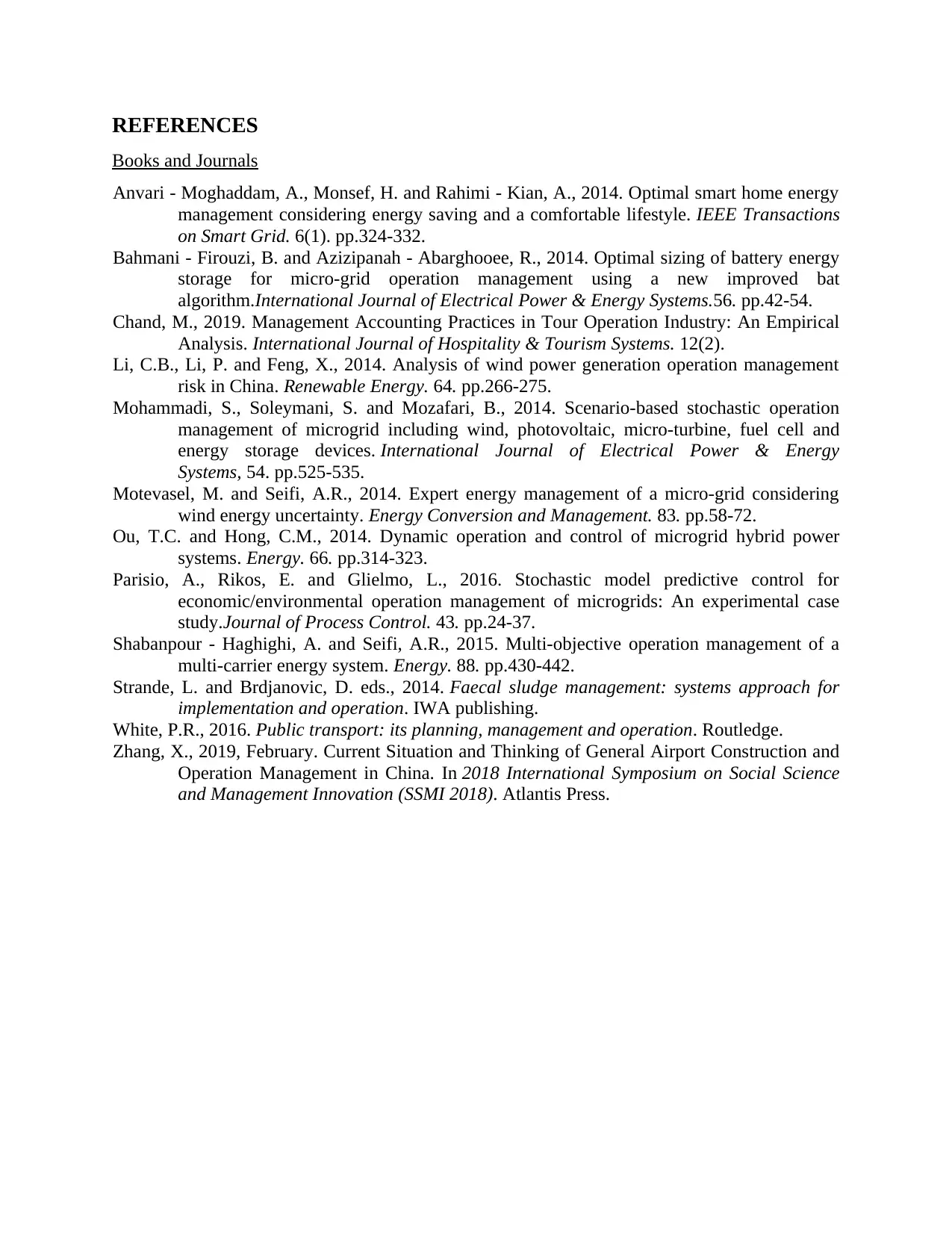
REFERENCES
Books and Journals
Anvari - Moghaddam, A., Monsef, H. and Rahimi - Kian, A., 2014. Optimal smart home energy
management considering energy saving and a comfortable lifestyle. IEEE Transactions
on Smart Grid. 6(1). pp.324-332.
Bahmani - Firouzi, B. and Azizipanah - Abarghooee, R., 2014. Optimal sizing of battery energy
storage for micro-grid operation management using a new improved bat
algorithm.International Journal of Electrical Power & Energy Systems.56. pp.42-54.
Chand, M., 2019. Management Accounting Practices in Tour Operation Industry: An Empirical
Analysis. International Journal of Hospitality & Tourism Systems. 12(2).
Li, C.B., Li, P. and Feng, X., 2014. Analysis of wind power generation operation management
risk in China. Renewable Energy. 64. pp.266-275.
Mohammadi, S., Soleymani, S. and Mozafari, B., 2014. Scenario-based stochastic operation
management of microgrid including wind, photovoltaic, micro-turbine, fuel cell and
energy storage devices. International Journal of Electrical Power & Energy
Systems, 54. pp.525-535.
Motevasel, M. and Seifi, A.R., 2014. Expert energy management of a micro-grid considering
wind energy uncertainty. Energy Conversion and Management. 83. pp.58-72.
Ou, T.C. and Hong, C.M., 2014. Dynamic operation and control of microgrid hybrid power
systems. Energy. 66. pp.314-323.
Parisio, A., Rikos, E. and Glielmo, L., 2016. Stochastic model predictive control for
economic/environmental operation management of microgrids: An experimental case
study.Journal of Process Control. 43. pp.24-37.
Shabanpour - Haghighi, A. and Seifi, A.R., 2015. Multi-objective operation management of a
multi-carrier energy system. Energy. 88. pp.430-442.
Strande, L. and Brdjanovic, D. eds., 2014. Faecal sludge management: systems approach for
implementation and operation. IWA publishing.
White, P.R., 2016. Public transport: its planning, management and operation. Routledge.
Zhang, X., 2019, February. Current Situation and Thinking of General Airport Construction and
Operation Management in China. In 2018 International Symposium on Social Science
and Management Innovation (SSMI 2018). Atlantis Press.
Books and Journals
Anvari - Moghaddam, A., Monsef, H. and Rahimi - Kian, A., 2014. Optimal smart home energy
management considering energy saving and a comfortable lifestyle. IEEE Transactions
on Smart Grid. 6(1). pp.324-332.
Bahmani - Firouzi, B. and Azizipanah - Abarghooee, R., 2014. Optimal sizing of battery energy
storage for micro-grid operation management using a new improved bat
algorithm.International Journal of Electrical Power & Energy Systems.56. pp.42-54.
Chand, M., 2019. Management Accounting Practices in Tour Operation Industry: An Empirical
Analysis. International Journal of Hospitality & Tourism Systems. 12(2).
Li, C.B., Li, P. and Feng, X., 2014. Analysis of wind power generation operation management
risk in China. Renewable Energy. 64. pp.266-275.
Mohammadi, S., Soleymani, S. and Mozafari, B., 2014. Scenario-based stochastic operation
management of microgrid including wind, photovoltaic, micro-turbine, fuel cell and
energy storage devices. International Journal of Electrical Power & Energy
Systems, 54. pp.525-535.
Motevasel, M. and Seifi, A.R., 2014. Expert energy management of a micro-grid considering
wind energy uncertainty. Energy Conversion and Management. 83. pp.58-72.
Ou, T.C. and Hong, C.M., 2014. Dynamic operation and control of microgrid hybrid power
systems. Energy. 66. pp.314-323.
Parisio, A., Rikos, E. and Glielmo, L., 2016. Stochastic model predictive control for
economic/environmental operation management of microgrids: An experimental case
study.Journal of Process Control. 43. pp.24-37.
Shabanpour - Haghighi, A. and Seifi, A.R., 2015. Multi-objective operation management of a
multi-carrier energy system. Energy. 88. pp.430-442.
Strande, L. and Brdjanovic, D. eds., 2014. Faecal sludge management: systems approach for
implementation and operation. IWA publishing.
White, P.R., 2016. Public transport: its planning, management and operation. Routledge.
Zhang, X., 2019, February. Current Situation and Thinking of General Airport Construction and
Operation Management in China. In 2018 International Symposium on Social Science
and Management Innovation (SSMI 2018). Atlantis Press.
1 out of 10
Related Documents
Your All-in-One AI-Powered Toolkit for Academic Success.
+13062052269
info@desklib.com
Available 24*7 on WhatsApp / Email
![[object Object]](/_next/static/media/star-bottom.7253800d.svg)
Unlock your academic potential
Copyright © 2020–2025 A2Z Services. All Rights Reserved. Developed and managed by ZUCOL.



